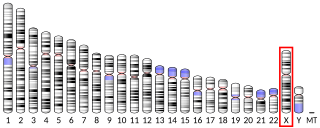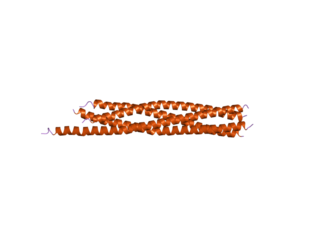
Hippocalcin is a protein that in humans is encoded by the HPCA gene.
Neuronal Calcium Sensor is a large family of proteins which work as calcium dependent molecular switches and includes members like Frequenin (NCS1), recoverin, GCAP, neurocalcin, visinin etc. All the members carry 4 EF hand motifs and an N-myristoyl group.

Kv7.3 (KvLQT3) is a potassium channel protein coded for by the gene KCNQ3.

Calsenilin is a protein that in humans is encoded by the KCNIP3 gene.

Potassium voltage-gated channel subfamily D member 2 is a protein that in humans is encoded by the KCND2 gene. It contributes to the cardiac transient outward potassium current (Ito1), the main contributing current to the repolarizing phase 1 of the cardiac action potential.

Kv channel-interacting protein 2 also known as KChIP2 is a protein that in humans is encoded by the KCNIP2 gene.

Voltage-dependent L-type calcium channel subunit beta-2 is a protein that in humans is encoded by the CACNB2 gene.

Hippocalcin-like protein 1 is a protein that in humans is encoded by the HPCAL1 gene.

Potassium voltage-gated channel subfamily D member 3 also known as Kv4.3 is a protein that in humans is encoded by the KCND3 gene. It contributes to the cardiac transient outward potassium current (Ito1), the main contributing current to the repolarizing phase 1 of the cardiac action potential.

Voltage-gated potassium channel subunit beta-1 is a protein that in humans is encoded by the KCNAB1 gene.

Dipeptidyl aminopeptidase-like protein 6 is a protein that in humans is encoded by the DPP6 gene.

DnaJ homolog subfamily C member 5, also known as cysteine string protein or CSP is a protein, that in humans encoded by the DNAJC5 gene. It was first described in 1990.

Voltage-dependent L-type calcium channel subunit beta-3 is a protein that in humans is encoded by the CACNB3 gene.

Potassium voltage-gated channel subfamily E member 4, originally named MinK-related peptide 3 or MiRP3 when it was discovered, is a protein that in humans is encoded by the KCNE4 gene.

Calcium-activated potassium channel subunit beta-4 is a protein that in humans is encoded by the KCNMB4 gene.

Potassium voltage-gated channel, Shal-related subfamily, member 1 (KCND1), also known as Kv4.1, is a human gene.

Kv channel-interacting protein 4 is a protein that in humans is encoded by the KCNIP4 gene.
Kv channel interacting proteins are members of a family of voltage-gated potassium (Kv) channel-interacting proteins, which belong to the recoverin branch of the EF-hand superfamily. Members of the KCNIP family are small calcium binding proteins. They all have EF-hand-like domains, and differ from each other in the N-terminus. They are integral subunit components of native Kv4 channel complexes. They may regulate A-type currents, and hence neuronal excitability, in response to changes in intracellular calcium. Alternative splicing results in multiple transcript variant encoding different isoforms.

KCNE1-like also known as KCNE1L is a protein that in humans is encoded by the KCNE1L gene.

Vesicle transport through interaction with t-SNAREs homolog 1A is a protein that in humans is encoded by the VTI1A gene.


























